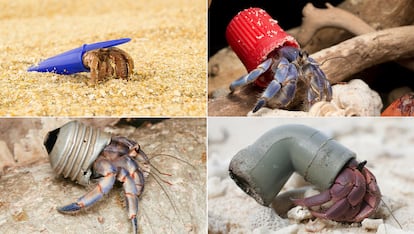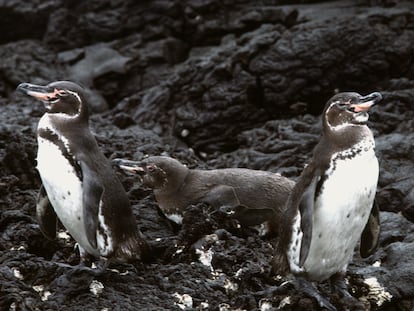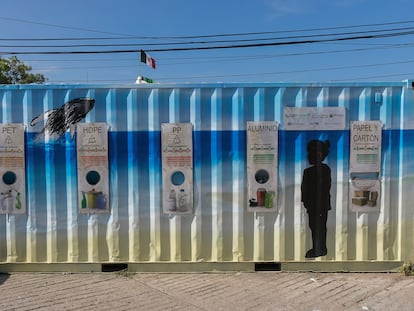Hermit crabs have swapped their shells for metal and plastic
Most of these crustaceans use pieces of garbage as homes, showing their ability to adapt to changing environments

Garbage like pellets, plastics and microplastics is inundating beaches worldwide. Surprisingly, hermit crabs have adapted and are using things like bottle caps, light bulbs and plastic cups as shells. A recent study published in Science of The Total Environment found that this behavior can be observed on a global scale, and most terrestrial hermit crab species now use trash as their shells.
Polish biologists conducted a study analyzing scientific literature and online videos, discovering 386 instances of crustaceans wrapped in garbage. These videos showcased specimens from 10 of the 16 hermit crab species found worldwide, spanning tropical regions from Africa to Central America. Interestingly, 85% of them utilized plastic scraps while the remaining used alternative materials like metal and glass. “We’ve just confirmed that hermit crabs all around the world are using artificial materials,” said biologist Zuzanna Jagiello, the study’s lead author.
The research team found that crabs prefer debris over shells because it’s easier to find along coasts and provides better camouflage. They also analyzed factors like odor, weight and sexual signaling. Carrying a heavier natural shell requires more energy, and the color and smell of plastic can help attract a partner. A study conducted in 2021 found that crabs are attracted to a chemical emitted by plastics.
However, there is a flip side to this story. In 2019, scientists discovered 414 million pieces of garbage washed up on the shores of the Cocos Islands, a remote Australian territory in the Indian Ocean. They analyzed the impacts of this waste on the region’s hermit crabs and found that over half a million had died, trapped in the man-made objects they inhabited.
The effects of replacing natural shells with plastic ones are unclear, but researchers believe it can lead to dangerous consequences, like turtles with straws stuck in their noses and sperm whales living with pounds of garbage in their stomachs. Jagiello finds it heartbreaking to see these creatures living in garbage, but acknowledges that they are simply adapting to their surroundings.
The intelligence of hermit crabs
Finding a house is no simple task. Hermits lead lives full of challenging decisions that demand advanced cognitive abilities. While research on the brains of hermit crabs is still in its infancy, initial studies have identified distinctions from other crabs. Notably, their spatial perception and exploration faculties are more developed. Strong memories enable them to recall shell characteristics, which saves time and energy in the long run.
Unlike most crabs, hermit crabs are born with soft bodies instead of naturally calcified abdomens. They live in shells for protection against predators, water currents (if they are marine crabs) and desiccation (if they are terrestrial). Selecting the best shell is crucial for a hermit crab — but how do they do it? First, they evaluate a shell with their eyes to gather information about its type, size and color. Then, using their legs and pincers, they explore the inside and outside to ensure it’s the right size. As they grow, they discard their shells and search for larger ones to molt into.
Hermit crabs also have exchange chains. When one finds a shell that’s too big, it keeps it nearby for another crab to use. As larger shells become available, the waiting crabs arrange themselves by size. Once the first crab makes the switch, an exchange chain happens and everyone gets a better shell. Crabs anticipate the need for new shells and organize themselves to facilitate relocation. Research confirms their ability to remember previously inhabited or inspected shells.
Photographer Shawn Miller contributed to the research by capturing images of crustaceans using debris as shells. One of his videos shows a crab moving from a piece of plastic to a natural shell. Miller says hermit crabs don’t choose to live permanently in plastic; they simply use it temporarily until they discover a more suitable natural shell.
The availability of natural shells is decreasing, while the volume of discarded plastic continues to increase. Mollusks make their own shells using calcium carbonate from seawater, but their numbers are dropping due to fishing pressure, rising ocean temperatures and water pollution. Greenpeace estimates plastic production surged by 900% between 1980 and 2020, exceeding 500 million tons annually. Many plastics end up in landfills instead of being recycled. Perhaps these pictures of hermit crabs inhabiting pieces of garbage will teach us a lesson about reusing plastic instead of discarding it.
Sign up for our weekly newsletter to get more English-language news coverage from EL PAÍS USA Edition
Tu suscripción se está usando en otro dispositivo
¿Quieres añadir otro usuario a tu suscripción?
Si continúas leyendo en este dispositivo, no se podrá leer en el otro.
FlechaTu suscripción se está usando en otro dispositivo y solo puedes acceder a EL PAÍS desde un dispositivo a la vez.
Si quieres compartir tu cuenta, cambia tu suscripción a la modalidad Premium, así podrás añadir otro usuario. Cada uno accederá con su propia cuenta de email, lo que os permitirá personalizar vuestra experiencia en EL PAÍS.
¿Tienes una suscripción de empresa? Accede aquí para contratar más cuentas.
En el caso de no saber quién está usando tu cuenta, te recomendamos cambiar tu contraseña aquí.
Si decides continuar compartiendo tu cuenta, este mensaje se mostrará en tu dispositivo y en el de la otra persona que está usando tu cuenta de forma indefinida, afectando a tu experiencia de lectura. Puedes consultar aquí los términos y condiciones de la suscripción digital.
More information
Últimas noticias
Most viewed
- Reinhard Genzel, Nobel laureate in physics: ‘One-minute videos will never give you the truth’
- Oona Chaplin: ‘I told James Cameron that I was living in a treehouse and starting a permaculture project with a friend’
- Pablo Escobar’s hippos: A serious environmental problem, 40 years on
- Charles Dubouloz, mountaineering star, retires at 36 with a farewell tour inspired by Walter Bonatti
- Why we lost the habit of sleeping in two segments and how that changed our sense of time











































